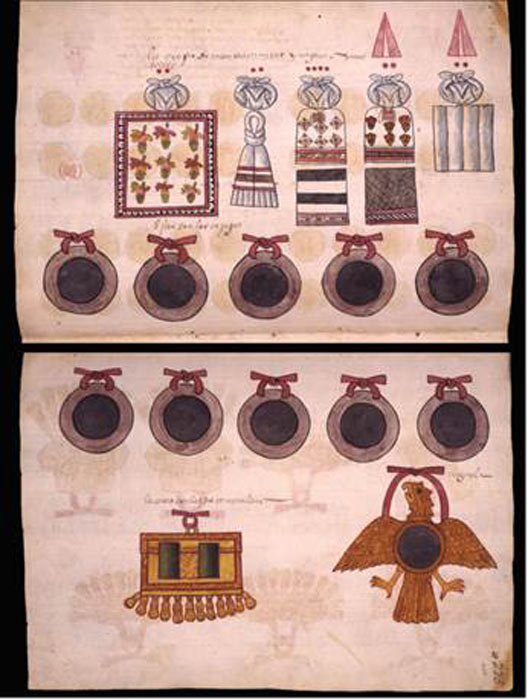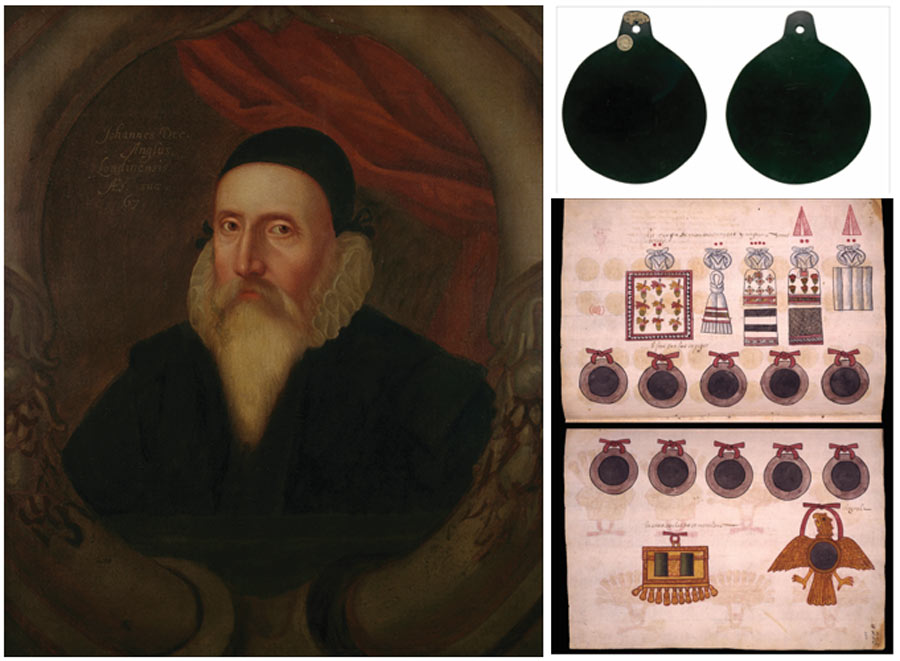New Study Verifies Aztec Manufacture of John Dee’s Obsidian Spirit Mirror
Archaeologists from the University of Manchester have just completed a new analysis of several alleged Aztec artifacts currently on display at the British Museum in London. Of special interest was a shiny black obsidian mirror, which belonged to the famed 16th century magician, scientist, court advisor, and occult devotee John Dee. After completing a high-tech geochemical analysis of this object, the archaeologists were able to confirm that the mirror in question did come from Mexico, and was in fact manufactured by a skilled Aztec artisan.
Geochemical Analysis Discloses the Truth
John Dee’s circular black obsidian mirror, which is approximately 7.5 inches (19 centimeters) in diameter, was first acquired by the British Museum in 1966. It is featured in the Museum’s Enlightenment Gallery, and it shares a display space with two very similar circular mirrors and one rectangular mirror that were all believed to be of Aztec origin. These artifacts were apparently shipped back to Europe from the New World in the 16th century, along with many other items that were either obtained through trade or seized as plunder during the Spanish conquest of Mexico and the Aztec Empire (1519-1521).
- Religion of the Aztecs: Keeping the Balance in an Unpredictable and Terrifying World
- Macuahuitl: Aztec Wooden ‘Paddles’ Are Obsidian Swords, Sharper Than Steel

The John Dee obsidian mirror (artifact 1) (S. Campbell / Antiquity Publications Ltd).
There was never any question that the mirrors at the British Museum were made based on Aztec designs. This was confirmed by extensive Aztec imagery that features drawings of these mysterious black mirrors, often in association with the Aztec deity Tezcatlipoca. But there was no direct proof they had come from Mexico or had been made by Aztec artisans. They could have been replicas made in Europe, and later incorrectly passed off as actual Aztec artifacts.
- John Dee: 16th Century Scholar, Astrologer, and Occult Practitioner
- 80 Days of Cuitlahuac: The Unforgettable Impact of a Late Aztec Emperor

Aztec depictions of obsidian mirrors. Codex Tepetlaoztoc (Codex Kingsborough) (© The Trustees of the British Museum / Antiquity Publications Ltd).
To confirm their authenticity, University of Manchester archaeologists Stuart Campbell and Elizabeth Healey performed a geochemical analysis of the obsidian used to make the mirrors. With a high-tech piece of equipment known as a portable X-ray fluorescence analyzer, they were able to create a detailed geochemical profile for each of the four obsidian mirrors they studied. They then performed the same tests on obsidian samples obtained on loan from the University of Missouri, which included rock mined from four separate ancient Aztec quarries in southern and central Mexico.
As the archaeologists explain in an article in the journal Antiquity, this comparison between geochemical signatures closed the case. X-ray fluorescence proved that the four mirrors were made from obsidian that had been mined in Mexico.
Dee’s mirror, and one other, was made from obsidian linked to the Pachuca site. Located in the heart of Aztec territory, this quarry supplied the majority of the obsidian used to manufacture both tools and specialized objects reserved for spiritual or supernatural purposes.
As Aztec lore makes clear, the shiny black mirrors held at the British Museum belong in the latter category. The Aztecs believed these mirrors could open doorways into other dimensions in space and time, where trained minds could travel seeking contact with spirits and knowledge about the afterlife and the underworld.
These special mirrors could also be used to predict the future. The god Tezcatlipoca was renowned for his prophetic abilities, and depictions of Tezcatlipoca would inevitably show him wearing several circular black mirrors on different parts of his body. Aztec shamans and others who worshipped this deity may have gazed into these circular mirrors for extended periods, attempting to enter altered states of consciousness that would allow them to see into the future to determine their individual fate, or the fate of the Aztec people.

Tezcatlipoca, lord of the smoking mirror, with circular obsidian mirrors on his temple, his chest and his foot highlighted (Codex Borgia) (figure by S. Campbell, after Díaz & Rodgers 1993 / Antiquity Publications Ltd).
John Dee’s Supernatural Quest Revealed
Shipping records from the time show a large number of these mirrors were shipped to collectors in the Hapsburg Empire, a central European power that ruled for centuries.
John Dee might have acquired his mirror when he lived in Bohemia (the modern-day Czech Republic) in the 1580s. It’s also possible he had it even longer, since he traveled widely in Europe throughout his adult life. Dee was well-known as both as an expert in magic and for his role as a close advisor to Queen Elizabeth I, and the aristocrats, politicians, diplomats, astrologers, and occult aficionados he met were delighted to give him gifts seeking his favor.

John Dee (c. 1594, anonymous) (© Ashmolean Museum, University of Oxford / Antiquity Publications Ltd).
Given John Dee’s fascination with the occult, he was likely drawn to the mirror because of its association with supernatural quests. Evidence given by individuals who came into possession of the mirror after Dee’s death in 1608 help confirm the nature of his interest.
In the late 18th century, the obsidian mirror was owned by English writer, art historian, and politician Horace Walpole, who served as the fourth Earl of Oxford. Walpole knew that the mirror had been passed from one Earl of Peterborough to another starting in the 17th century, and he was in possession of a catalog that listed all the valuable objects that had been held in the Earls of Peterborough collection past and present. In 1784, Walpole said the now lost catalog referred to the mirror as “the black stone into which Dr. Dee used to call his spirits.”
Either the first or second Earl of Peterborough likely purchased the mirror within two or three decades of Dee’s death. They may have known about the object’s occult connections from John Pontois, an associate of John Dee’s who inherited Dee’s book collection and many other valued items after Dee’s death.
A written deposition left by an individual who’d seen the mirror while it was in Pontois’s possession described it as “a certain round flat stone like Cristall [crystal], which Pontois said was a stone which an Angell [angel] brought to doctor dye [Dee] wherein he did worke and know many strange things.”
Presumably, it was their knowledge of how John Dee used the obsidian mirror that motivated either the first or second Earl of Peterborough to purchase the mirror from whoever had inherited it after Pontois’s death in 1624.
Until it came into the possession of the British Museum in 1966, Dee’s magical black mirror passed through many hands. While some who purchased or inherited it may have viewed it simply as a collector’s item, others may have attempted to re-create Dee’s experiments in an effort to connect to the spirit world.

Other obsidian mirrors and rectangular slab in the British Museum (artefacts 2–3 and 19) (figure by S. Campbell / Antiquity Publications Ltd).
An Obsidian Mirror into Ancient Minds
John Dee himself never wrote about the Aztec mirror. But he did write about his interest in spirit communication with deceased humans and with angels, and also about his interest in prophecy and divination.
The Aztecs were also interested in such things, as Dee would have known from his readings of European ethnographers who’d written books about the Aztecs and other inhabitants of the New World in the years following the Spanish conquest. The mirror’s connection to these exotic and mysterious people undoubtedly added to its mystique, making it exactly the type of object a dedicated occultist and magician like Dee would have desired.
Given the mirror’s small size, it would have been easy for it to have been lost somewhere in the distant past. But items from Dee’s collection were highly coveted and carefully preserved by collectors who acquired them, from the 17th century into the modern era. His reputation as an occult legend has never dimmed, and the public’s fascination with his life and work helped ensure that his Aztec spirit mirror would be neither thrown away nor forgotten.
The finely-crafted object reveals something about John Dee’s life and interests. But to trained archaeologists, it reveals even more about the people who conceived of its design, built a belief system around it, and used it for their own unique spiritual purposes.
Top image: John Dee, his obsidian mirror and Aztec design of obsidian mirrors. Source: Antiquity Publications Ltd
By Nathan Falde




















Comments
Making anything from obsisian is not easy. It may be even more brittle than common glass, but that does not mean that it can’t be done. There are many objects made from that precious substance that were recovered from many burials in North and Central America, most likely from the Aztecs. Polishing to a mirror finish just takes a LOT of rubbing with finer and finer grits of sand. Don’t forgert the skulls made from rock crystal, those are even more impressive to me than the mirrors.